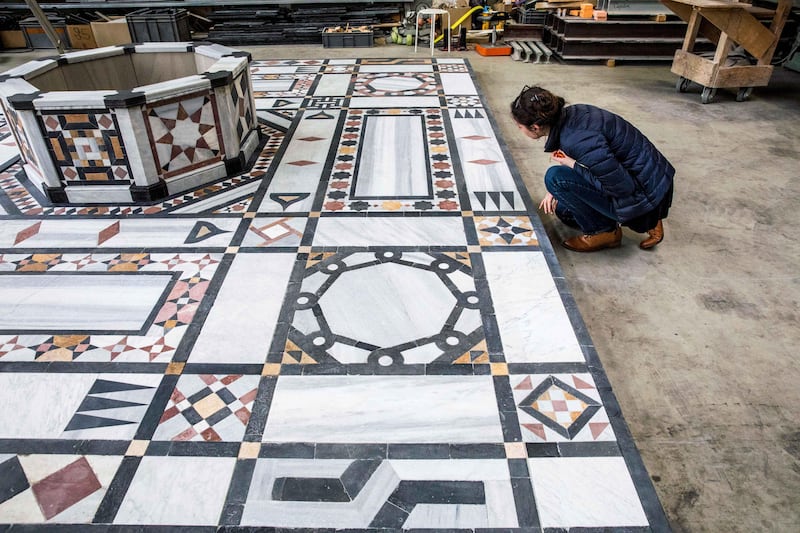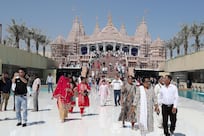In Christophe Laporte’s expert hands, 1,900 kilograms of Ottoman masonry – black and yellow, red and white - come apart and recombine like so many multi-coloured shapes in the lens of a kaleidoscope.
A master restorer with the physique of a rugby player, Laporte is reassembling what amounts to a 118-piece jigsaw on the floor of the atelier where he’s worked for the last 34 years, The Studio for the Restoration of Mosaics and Painted Plasters in Saint-Romain-en-Gal, a small town on the banks of the River Rhône, 20 miles south of Lyon.
Saint-Romain-en-Gal and its larger cross-river neighbour, Vienne, are home to some of the finest Roman and Gallo-Roman archaeological remains to be found anywhere in France, and thanks to the sheer number of mosaics that have been found there, the conservation studio has become an internationally-recognised centre of excellence.
For the last seven months, Laporte and a specially assembled team of independent experts have been carefully recording, cleaning and conserving the stone - an 18th century pavement and fountain that once graced the courtyard of a grand mansion in Damascus - transforming it from an important but poorly maintained collector's item into a museum-grade artefact fit for the permanent collection of the Louvre Abu Dhabi.
"When people see the geometry and colours, the contrast between the black and white, and when they see and hear the water that will be in the fountain, not only will it be calming and restful, but I'm sure it will have a real impact," explains Souraya Noujaim, curator of Islamic Art with Agence France-Muséums, the organisation responsible for coordinating the expertise required for the new museum.
“It will be located in a space just off the main route in an area that, just between the team members, we refer to as the Damascus Court,” the art historian says of the piece, which will be one of the very few objects from the museum’s collection to be displayed permanently outside.
An example of the ablaq-‘ajami style of Damascene decoration, which flourished from the 17th until the early 19th centuries, the pavement and its fountain would originally have been intended for a qa’a, or salon, the focal point for a household where guests would also have been received and entertained.
In this instance, the Arabic word ablaq means black and white-coloured, or piebald, while ‘ajami, refers to the brightly-coloured, geometrically patterned woodwork that would have adorned the salon’s walls and ceiling, providing a softer, warmer accompaniment to the stone floor while completing the salon’s interior design.
In the Louvre Abu Dhabi pavement, the black, white, yellow and red colouring is provided by a schist-like stone, Turkish Marmara marble and stones traditionally quarried from Damascus and Aleppo and when it is installed in the museum’s external plaza, it will be complemented not by ‘ajami, but by the complex geometry of Jean Nouvel’s multi-layered canopy, which is composed of 12,000-tonnes of aluminium and steel.
“First and foremost, this is an example of a grand decor from a certain period, but for me, the second message is the dialogue that will result between the artwork and the museum's modern architecture,” Noujaim suggests.
“I’m not trying to compete with Jean Nouvel’s architecture, but I really see a connection between this piece and the [museum’s] dome.”
For the curator, that dialogue is encapsulated in the notion of handasah, an Arabic word that is now commonly used to refer to engineering, but whose etymology also contains more profound notions of composition and design.
"In ancient times, the word had multiple layers of meaning - one of which was about putting things in harmony - and I think that is one of the ways in which the dialogue between the pavement and the dome's geometry can be understood, Noujaim says.
“Inside the museum, we have many objects that speak about the East meeting the West, but the pavement is about the past meeting the present.”
Organised symmetrically around its central, octagonal fountain, the pavement’s alternating rectangles and squares are made from white and grey Turkish marble, yellow and red stone quarried locally to Aleppo and Damascus, and a smooth, black stone that is believed to be schist.
The mixture of colours and stones not only echoes the patterns and motifs of the late Islamic Ayyubid and Mamluk periods, particularly in its use of chain and knot and S-shaped motifs, but also looks further back to the far older Byzantine use of black basalt and pale limestone, which inspired the decoration of medieval churches and palaces, from Aix-la-Chapelle in Germany, to Sicily and the Levant.
Among the pavement’s many polygons and stars, squares and rosettes however, there are two small black and white panels that feature a motif that cannot be explained, and which has captured the conservator’s imaginations.
Made not from cut stone but from a piece of black stone with white stone laid into it. The pattern could be a maker’s mark, but also looks like the Arabic letter meem, written in a very angular but recognisable form of kufic script and if it is, Noujaim suggests, the letter might refer to the pavement’s fountain and the Arabic word for water, ma’iyy.
By the time the team from the Louvre Abu Dhabi acquired the pavement on the European art market in 2011, its stone panels had been bound together with resin and iron rods, a conservation technique that was not only crude but damaging: as the rods had aged and corroded, and the rust was staining the mosaic.
But before any remedial or cleaning works could begin, the conservation team first had to record every element of the pavement in order to understand how it was constructed the expertise and techniques its conservation would require.
The pavement’s initial assessment was conducted by Evelyne Chantriaux, the founder and director of the Saint-Romain-en-Gal workshop, which she established in 1980.
A board member of the International Committee for the Conservation of Mosaics, Chantriaux has worked on mosaics from North Africa and the Levant, as well as France, the largest of which, a 120 square metre floor from a 6th-century church in Qabr Hiram, Lebanon, took 10 years to conserve, and is now on permanent display at the Musée du Louvre.
“The first task was to go and see the work and evaluate it, in French we call it 'allez voir',” she says. “And from what I could see, I thought that it would be a very long job, because of the condition of the pavement and that's when I had the idea of assembling a team.”
After 37 years at the workshop and in the industry, Chantriaux was able to turn to her existing network of independent colleagues to form her team that included the conservators Patrick Blanc, Laurence Krougly and Gaëlle Giralt, the archaeologist and conservator Magdalena Monraval and the specialist sculpture restorer Emmanuel Desroches.
Although the experts all knew each other, it was the first time they had come together to work on the same project.
After every piece of the mosaic had been recorded, photographed and numbered, the next phase of the conservation was to turn the whole pavement over so that the process of undoing the work previous generations could begin.
“Once we had turned it over, we were able to start removing the resin and the iron bars from the modern restoration, but even this took 4 people 2 months to complete,” explains the softly spoken Emmanuel Desroches.
Before the pavement could then be righted for cleaning, a new backing layer had to be applied that would provide the necessary structural stability.
“One of the challenges was to conceive of the conservation in a way that would allow the pavement to be constructed but that can also be disassembled and is easy to reverse,” says Chantriaux, with a view to the possible needs of future generations of conservators.
“And another challenge for the team was to select materials that could withstand the very challenging climatic conditions in Abu Dhabi, that can deal with the high temperatures and the humidity.”
The result, a sandwich of synthetic mortars, glass textile, resin and pumice, that not only binds the surface mosaic together, but is also light, a key consideration when it comes to transporting the pavement.
Once this was applied, it was time for the delicate business of cleaning to begin, a process that each member of the team approached from a slightly different perspective.
For Emmanuel Desroches, the issues of what is desirable and what is possible are intimately connected.
“This was a pavement, so it had experienced life and this had left the usual traces, so once we had established what was desirable and how far we should we started cleaning with very simple and light techniques” he explains.
“Not only did we have different materials to clean, but we also had different types of stains and pollutants that had to be removed. Some were metal stains, from the corrosion, but others were caused by lipids, each of which requires a different approach.”
“For me, not as a conservator or a technician but as a curator, the cleaning is really about giving the art piece back its original life. It's about not doing too much,” Souraya Noujaim explains.
“Time has passed and time is also beautiful - it's part of the life of the artwork – so for me cleaning is really about making the object aesthetically readable and giving it some of its old glory.”
nleech@thenational.ae





